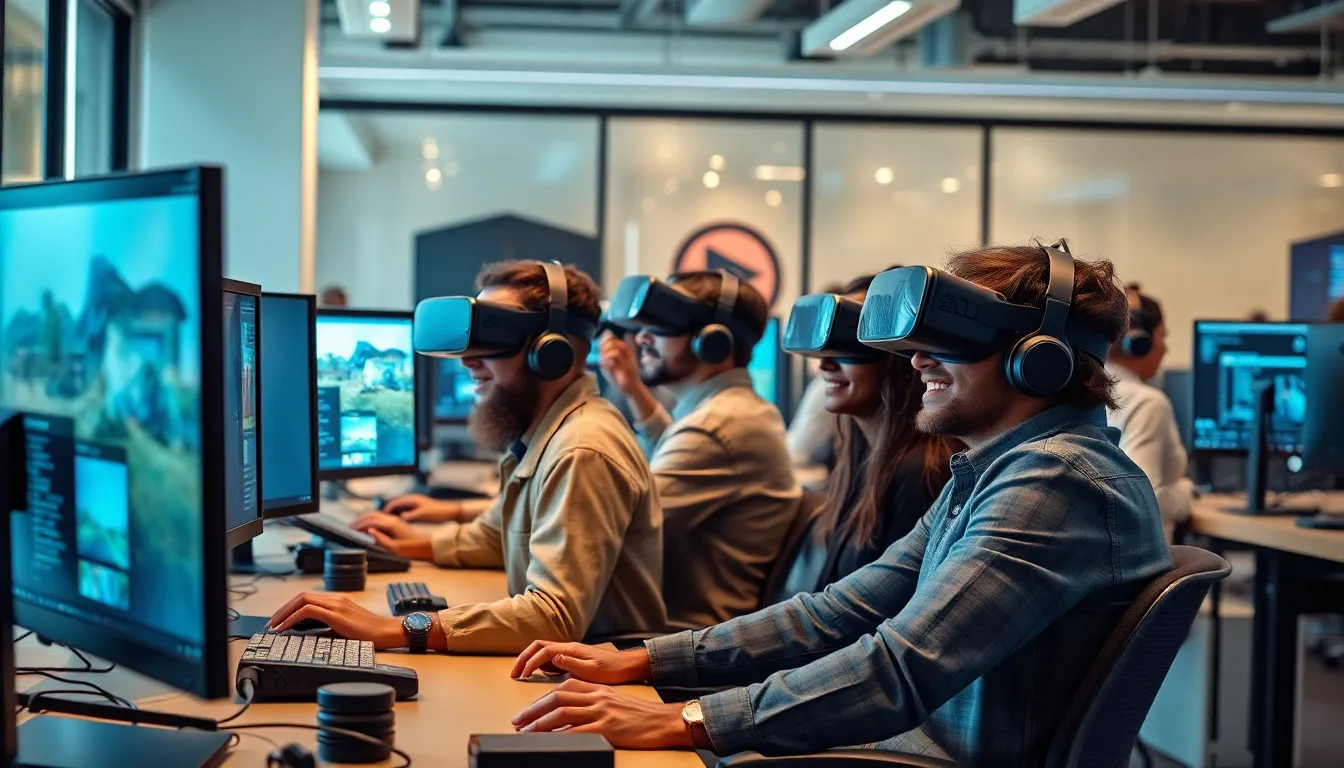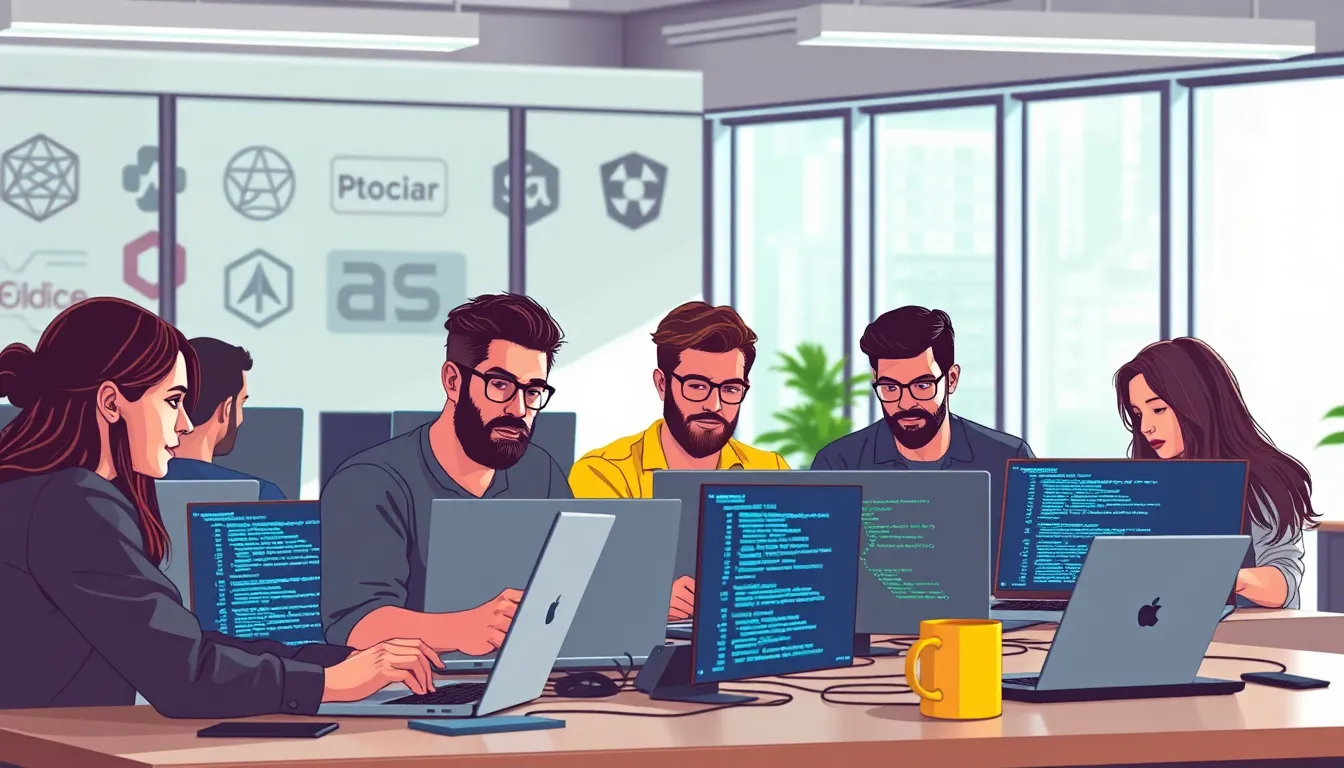Imagine stepping into a world where the impossible becomes possible, where your wildest dreams blend seamlessly with reality. Welcome to the fascinating realm of augmented and virtual reality programming. With a sprinkle of creativity and a dash of tech wizardry, developers are crafting experiences that make video games feel like child’s play and training simulations resemble sci-fi blockbusters.
Table of Contents
ToggleUnderstanding AR and VR Programming
AR and VR programming encompasses technologies that create interactive experiences in real-world and virtual environments. These fields blend creativity and advanced coding skills, opening opportunities in various industries.
What Are AR and VR?
AR, or augmented reality, overlays digital elements onto the real world. Examples include mobile apps that enhance retail experiences or educational tools that provide interactive learning. In contrast, VR, or virtual reality, immerses users in fully simulated environments. Gamers often utilize VR headsets for rich, immersive gameplay experiences. Both technologies rely on sophisticated programming techniques to enhance user engagement.
Key Differences Between AR and VR
AR integrates digital content with the physical world, enhancing reality rather than replacing it. Users often experience AR through smartphones or tablets. On the other hand, VR transports users into entirely virtual environments, requiring headsets for immersion. Interaction levels differ, as AR typically allows interaction with both digital and physical elements, while VR focuses on user experiences within a fictional space. Understanding these differences aids developers in creating appropriate applications for their intended audiences.
Tools and Frameworks for AR and VR Development

AR and VR development relies on various tools and frameworks that facilitate the creation of immersive experiences. Understanding these tools enhances a developer’s ability to deliver engaging applications.
Popular AR and VR Platforms
Unity serves as a leading platform, providing powerful tools for both AR and VR projects. Unreal Engine is another popular choice, known for delivering high-quality graphics and excellent performance. ARKit, developed by Apple, enables developers to create AR applications for iOS devices, while ARCore by Google provides similar functionality for Android. Microsoft’s HoloLens supports mixed reality experiences, integrating digital elements seamlessly with the real world. Lastly, Vuforia offers robust tracking capabilities for building AR applications on various devices.
Programming Languages Used in AR and VR
C# remains a primary language for Unity development, providing flexibility and control. C++ is essential for Unreal Engine, allowing low-level manipulation for performance optimization. JavaScript offers versatility in web-based AR applications, particularly when leveraging WebXR APIs. Swift plays a crucial role in ARKit applications, enabling developers to utilize native iOS features. Python finds its way into AR and VR through machine learning and data processing tasks. Each language fulfills specific requirements in AR and VR development, contributing to the richness of user experiences.
Best Practices in AR and VR Programming
Developing effective AR and VR experiences requires careful planning and attention to detail. Developers focusing on user-centric design and system performance often achieve the best results.
User Experience Design Considerations
User experience design remains vital for AR and VR applications. Prioritizing intuitive navigation will enhance user engagement. Creating an immersive environment through sound, visuals, and interactive elements boosts realism. Developers often utilize feedback mechanisms to gauge user interaction. Scalable interfaces allow seamless transitions when users switch between tasks. Simple, clear instructions throughout the experience ensure users remain informed. This approach reduces confusion and improves overall satisfaction with the application.
Performance Optimization Techniques
Performance optimization plays a key role in AR and VR programming. Minimizing latency is essential to prevent motion sickness among users. Reducing draw calls can significantly enhance frame rates. Employing LOD (Level of Detail) techniques allows complex models to load efficiently. Developers often leverage occlusion culling to improve rendering performance. Utilizing asset compression techniques saves memory while maintaining quality. Profiling tools enable tracking of performance metrics during development. By prioritizing these strategies, developers can deliver smooth, responsive experiences that captivate users.
Future Trends in AR and VR Programming
Innovations in augmented reality and virtual reality programming are rapidly evolving. Developers anticipate significant enhancements in user interaction and technology integration.
Emerging Technologies
Advanced technologies like 5G and artificial intelligence will transform AR and VR experiences. 5G technology offers higher speeds and lower latency, enabling real-time interactions that enhance immersion. Artificial intelligence streamlines content creation and personalization, tailoring experiences based on user preferences. Spatial computing, which combines elements of both AR and VR within physical spaces, will further blur the lines between real and virtual environments. Furthermore, haptic feedback technologies will enhance users’ tactile experiences, making interactions feel more realistic. As these technologies progress, they’ll create innovative opportunities in various sectors.
Potential Applications Across Industries
The potential applications of AR and VR span numerous industries, showcasing their versatility. In healthcare, medical training programs use VR simulations to provide safe learning environments for practitioners. Retailers leverage AR to allow customers to visualize products in their spaces before purchase, enhancing decision-making. Education benefits from immersive learning experiences through virtual classrooms, fostering engagement and retention. Architecture and design professionals utilize AR for real-time project visualization, improving collaboration with clients. Moreover, entertainment industries incorporate AR and VR for interactive experiences that redefine audience engagement. Each of these applications highlights the broad impact of AR and VR across multiple sectors.
The landscape of AR and VR programming is evolving rapidly as developers harness creativity and technology to craft immersive experiences. With the right tools and frameworks, they can tap into endless possibilities across various industries. The emphasis on user-centric design and performance optimization is key to creating applications that truly engage users.
As advancements continue to unfold, the integration of technologies like 5G and AI will further enhance these experiences. The future holds exciting prospects for AR and VR, promising to redefine how users interact with both digital and physical worlds. Embracing these innovations will not only benefit developers but also enrich the experiences of users everywhere.






